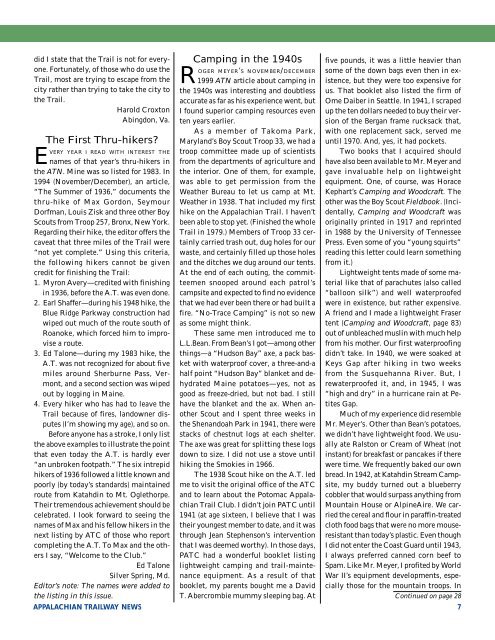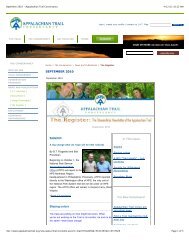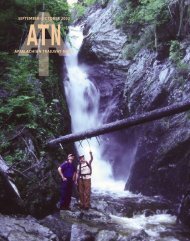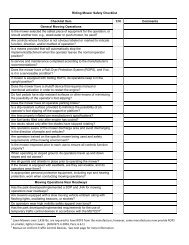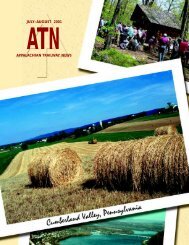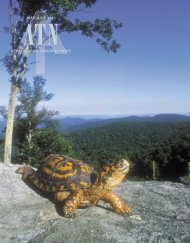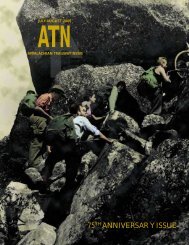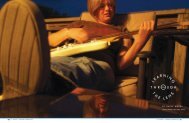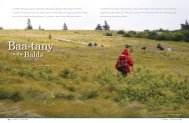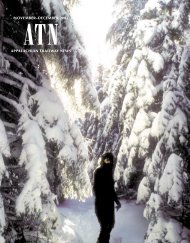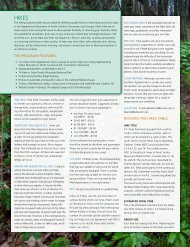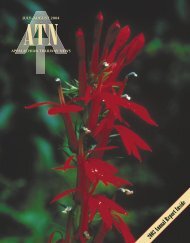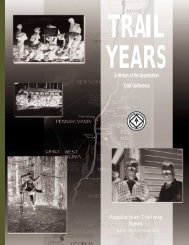atn mayâjune 2000 appalachian trailway news
atn mayâjune 2000 appalachian trailway news
atn mayâjune 2000 appalachian trailway news
You also want an ePaper? Increase the reach of your titles
YUMPU automatically turns print PDFs into web optimized ePapers that Google loves.
Camping in the 1940s<br />
did I state that the Trail is not for everyone.<br />
Fortunately, of those who do use the<br />
OGER MEYER’S NOVEMBER/DECEMBER some of the down bags even then in ex-<br />
five pounds, it was a little heavier than<br />
Trail, most are trying to escape from the R 1999 ATN article about camping in istence, but they were too expensive for<br />
city rather than trying to take the city to<br />
the Trail.<br />
Harold Croxton<br />
Abingdon, Va.<br />
the 1940s was interesting and doubtless<br />
accurate as far as his experience went, but<br />
I found superior camping resources even<br />
ten years earlier.<br />
As a member of Takoma Park,<br />
us. That booklet also listed the firm of<br />
Ome Daiber in Seattle. In 1941, I scraped<br />
up the ten dollars needed to buy their version<br />
of the Bergan frame rucksack that,<br />
with one replacement sack, served me<br />
The First Thru-hikers? Maryland’s Boy Scout Troop 33, we had a until 1970. And, yes, it had pockets.<br />
VERY YEAR I READ WITH INTEREST THE troop committee made up of scientists Two books that I acquired should<br />
E names of that year’s thru-hikers in from the departments of agriculture and have also been available to Mr. Meyer and<br />
the ATN. Mine was so listed for 1983. In<br />
1994 (November/December), an article,<br />
“The Summer of 1936,” documents the<br />
thru-hike of Max Gordon, Seymour<br />
Dorfman, Louis Zisk and three other Boy<br />
Scouts from Troop 257, Bronx, New York.<br />
Regarding their hike, the editor offers the<br />
caveat that three miles of the Trail were<br />
“not yet complete.” Using this criteria,<br />
the following hikers cannot be given<br />
credit for finishing the Trail:<br />
1. Myron Avery—credited with finishing<br />
in 1936, before the A.T. was even done.<br />
2. Earl Shaffer—during his 1948 hike, the<br />
Blue Ridge Parkway construction had<br />
wiped out much of the route south of<br />
Roanoke, which forced him to improvise<br />
a route.<br />
3. Ed Talone—during my 1983 hike, the<br />
A.T. was not recognized for about five<br />
miles around Sherburne Pass, Vermont,<br />
and a second section was wiped<br />
out by logging in Maine.<br />
4. Every hiker who has had to leave the<br />
Trail because of fires, landowner disputes<br />
(I’m showing my age), and so on.<br />
Before anyone has a stroke, I only list<br />
the above examples to illustrate the point<br />
that even today the A.T. is hardly ever<br />
“an unbroken footpath.” The six intrepid<br />
hikers of 1936 followed a little known and<br />
poorly (by today’s standards) maintained<br />
route from Katahdin to Mt. Oglethorpe.<br />
Their tremendous achievement should be<br />
celebrated. I look forward to seeing the<br />
names of Max and his fellow hikers in the<br />
next listing by ATC of those who report<br />
completing the A.T. To Max and the others<br />
I say, “Welcome to the Club.”<br />
Ed Talone<br />
Silver Spring, Md.<br />
Editor’s note: The names were added to<br />
the listing in this issue.<br />
the interior. One of them, for example,<br />
was able to get permission from the<br />
Weather Bureau to let us camp at Mt.<br />
Weather in 1938. That included my first<br />
hike on the Appalachian Trail. I haven’t<br />
been able to stop yet. (Finished the whole<br />
Trail in 1979.) Members of Troop 33 certainly<br />
carried trash out, dug holes for our<br />
waste, and certainly filled up those holes<br />
and the ditches we dug around our tents.<br />
At the end of each outing, the committeemen<br />
snooped around each patrol’s<br />
campsite and expected to find no evidence<br />
that we had ever been there or had built a<br />
fire. “No-Trace Camping” is not so new<br />
as some might think.<br />
These same men introduced me to<br />
L.L.Bean. From Bean’s I got—among other<br />
things—a “Hudson Bay” axe, a pack basket<br />
with waterproof cover, a three-and-a<br />
half point “Hudson Bay” blanket and dehydrated<br />
Maine potatoes—yes, not as<br />
good as freeze-dried, but not bad. I still<br />
have the blanket and the ax. When another<br />
Scout and I spent three weeks in<br />
the Shenandoah Park in 1941, there were<br />
stacks of chestnut logs at each shelter.<br />
The axe was great for splitting these logs<br />
down to size. I did not use a stove until<br />
hiking the Smokies in 1966.<br />
The 1938 Scout hike on the A.T. led<br />
me to visit the original office of the ATC<br />
and to learn about the Potomac Appalachian<br />
Trail Club. I didn’t join PATC until<br />
1941 (at age sixteen, I believe that I was<br />
their youngest member to date, and it was<br />
through Jean Stephenson’s intervention<br />
that I was deemed worthy). In those days,<br />
PATC had a wonderful booklet listing<br />
lightweight camping and trail-maintenance<br />
equipment. As a result of that<br />
booklet, my parents bought me a David<br />
T. Abercrombie mummy sleeping bag. At<br />
gave invaluable help on lightweight<br />
equipment. One, of course, was Horace<br />
Kephart’s Camping and Woodcraft. The<br />
other was the Boy Scout Fieldbook. (Incidentally,<br />
Camping and Woodcraft was<br />
originally printed in 1917 and reprinted<br />
in 1988 by the University of Tennessee<br />
Press. Even some of you “young squirts”<br />
reading this letter could learn something<br />
from it.)<br />
Lightweight tents made of some material<br />
like that of parachutes (also called<br />
“balloon silk”) and well waterproofed<br />
were in existence, but rather expensive.<br />
A friend and I made a lightweight Fraser<br />
tent (Camping and Woodcraft, page 83)<br />
out of unbleached muslin with much help<br />
from his mother. Our first waterproofing<br />
didn’t take. In 1940, we were soaked at<br />
Keys Gap after hiking in two weeks<br />
from the Susquehanna River. But, I<br />
rewaterproofed it, and, in 1945, I was<br />
“high and dry” in a hurricane rain at Petites<br />
Gap.<br />
Much of my experience did resemble<br />
Mr. Meyer’s. Other than Bean’s potatoes,<br />
we didn’t have lightweight food. We usually<br />
ate Ralston or Cream of Wheat (not<br />
instant) for breakfast or pancakes if there<br />
were time. We frequently baked our own<br />
bread. In 1942, at Katahdin Stream Campsite,<br />
my buddy turned out a blueberry<br />
cobbler that would surpass anything from<br />
Mountain House or AlpineAire. We carried<br />
the cereal and flour in paraffin-treated<br />
cloth food bags that were no more mouseresistant<br />
than today’s plastic. Even though<br />
I did not enter the Coast Guard until 1943,<br />
I always preferred canned corn beef to<br />
Spam. Like Mr. Meyer, I profited by World<br />
War II’s equipment developments, especially<br />
those for the mountain troops. In<br />
Continued on page 28<br />
APPALACHIAN TRAILWAY NEWS 7


